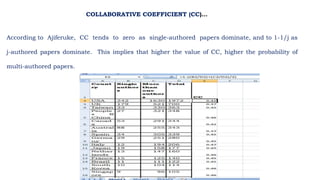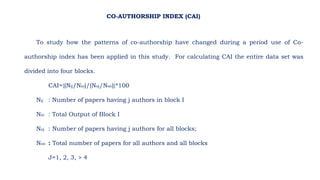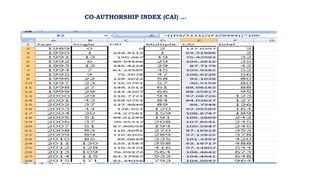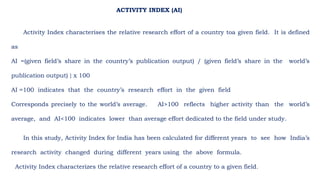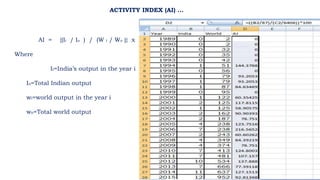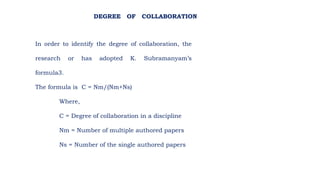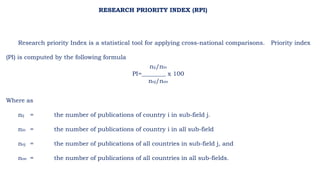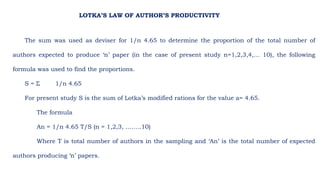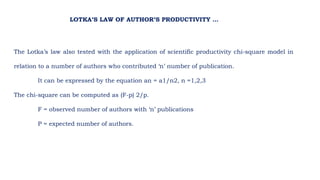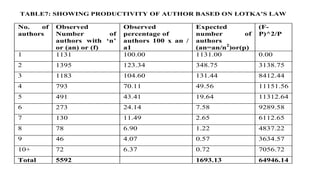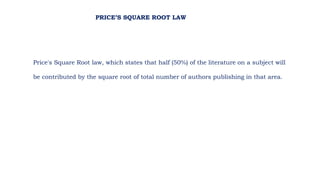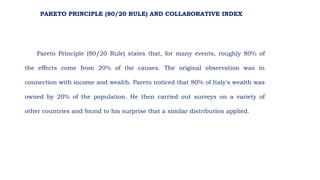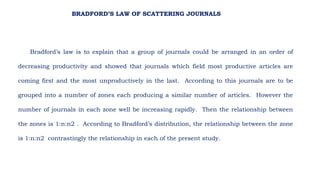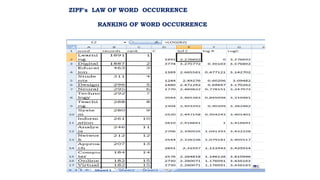Relative Growth Rate ppt.ppt
- 1. ï· Relative Growth Rate (RGR) ï· Doubling Time (Dt) ï· Collaborative Coefficient (CC) ï· Activity Index (AI) ï· Co-authorship Index(CAI) ï· Author Productivity ï· Degree of Collaboration ï· Bradford Law of Scattering and Lotkaâs Law ï· Priority Index (RPI) Contents
- 2. Relative Growth Rate (RGR) The mean relative growth rate R-(1-2) over a specified period of interval can be calculated from the following equation. W2-W1 R(1-2) = ----------- T2-T1 Where, R (1-2) = Mean relative growth rate over the specified period interval; W1 = log w1 (Natural log of initial number of publications) W2 = log w2 (Natural log of initial number of publications) T2-T1 = the unit difference between the initial time and final time.
- 3. DOUBLING TIME Doubling time (Dt) = 0.693/R(a) Therefore, Doubling time for publications Dt(a) = 0.693 / R (a)
- 4. The pattern of co-authorship among different countries have been examined by making use of Collaborative Coefficient (CC) suggested by Ajiferuke e.tal (1988). The formula used for calculating CC is as follows. Where k CC=1-[â (1/j)Fj/N] J=1 Fj=the number of authored papers N=total number of research published; and k=the greatest number of authors per paper COLLABORATIVE COEFFICIENT (CC)
- 5. According to Ajiferuke, CC tends to zero as single-authored papers dominate, and to 1-1/j as j-authored papers dominate. This implies that higher the value of CC, higher the probability of multi-authored papers. COLLABORATIVE COEFFICIENT (CC)âĶ
- 6. To study how the patterns of co-authorship have changed during a period use of Co- authorship index has been applied in this study. For calculating CAI the entire data set was divided into four blocks. CAI={(Nij/Nio)/(Noj/Noo)}*100 Nij : Number of papers having j authors in block I Nio : Total Output of Block I Noj : Number of papers having j authors for all blocks; Noo : Total number of papers for all authors and all blocks J=1, 2, 3, > 4 CO-AUTHORSHIP INDEX (CAI)
- 7. CO-AUTHORSHIP INDEX (CAI) âĶ
- 8. Activity Index characterises the relative research effort of a country toa given field. It is defined as AI =(given fieldâs share in the countryâs publication output) / (given fieldâs share in the worldâs publication output) } x 100 AI =100 indicates that the countryâs research effort in the given field Corresponds precisely to the worldâs average. AI>100 reflects higher activity than the worldâs average, and AI<100 indicates lower than average effort dedicated to the field under study. In this study, Activity Index for India has been calculated for different years to see how Indiaâs research activity changed during different years using the above formula. Activity Index characterizes the relative research effort of a country to a given field. ACTIVITY INDEX (AI)
- 9. AI = {(Ii / Io ) / (W i / Wo )} x 100 Where Ii=Indiaâs output in the year i Io=Total Indian output wi=world output in the year i wo=Total world output ACTIVITY INDEX (AI) âĶ
- 10. In order to identify the degree of collaboration, the research or has adopted K. Subramanyamâs formula3. The formula is C = Nm/(Nm+Ns) Where, C = Degree of collaboration in a discipline Nm = Number of multiple authored papers Ns = Number of the single authored papers DEGREE OF COLLABORATION
- 11. Research priority Index is a statistical tool for applying cross-national comparisons. Priority index (PI) is computed by the following formula nij/nio PI=________ x 100 noj/noo Where as nij = the number of publications of country i in sub-field j. nio = the number of publications of country i in all sub-field noj = the number of publications of all countries in sub-field j, and noo = the number of publications of all countries in all sub-fields. RESEARCH PRIORITY INDEX (RPI)
- 12. The sum was used as deviser for 1/n 4.65 to determine the proportion of the total number of authors expected to produce ânâ paper (in the case of present study n=1,2,3,4,âĶ 10), the following formula was used to find the proportions. S = ÎĢ 1/n 4.65 For present study S is the sum of Lotkaâs modified rations for the value a= 4.65. The formula An = 1/n 4.65 T/S (n = 1,2,3, âĶâĶ..10) Where T is total number of authors in the sampling and âAnâ is the total number of expected authors producing ânâ papers. LOTKAâS LAW OF AUTHORâS PRODUCTIVITY
- 13. LOTKAâS LAW OF AUTHORâS PRODUCTIVITY âĶ The Lotkaâs law also tested with the application of scientific productivity chi-square model in relation to a number of authors who contributed ânâ number of publication. It can be expressed by the equation an = a1/n2, n =1,2,3 The chi-square can be computed as (F-p) 2/p. F = observed number of authors with ânâ publications P = expected number of authors.
- 14. TABLE7: SHOWING PRODUCTIVITY OF AUTHOR BASED ON LOTKAâS LAW No. of authors Observed Number of authors with ânâ or (an) or (f) Observed percentage of authors 100 x an / a1 Expected number of authors (an=an/n2 )or(p) (F- P)^2/P 1 1131 100.00 1131.00 0.00 2 1395 123.34 348.75 3138.75 3 1183 104.60 131.44 8412.44 4 793 70.11 49.56 11151.56 5 491 43.41 19.64 11312.64 6 273 24.14 7.58 9289.58 7 130 11.49 2.65 6112.65 8 78 6.90 1.22 4837.22 9 46 4.07 0.57 3634.57 10+ 72 6.37 0.72 7056.72 Total 5592 1693.13 64946.14
- 15. Price's Square Root law, which states that half (50%) of the literature on a subject will be contributed by the square root of total number of authors publishing in that area. PRICEâS SQUARE ROOT LAW
- 16. Pareto Principle (80/20 Rule) states that, for many events, roughly 80% of the effects come from 20% of the causes. The original observation was in connection with income and wealth. Pareto noticed that 80% of Italy's wealth was owned by 20% of the population. He then carried out surveys on a variety of other countries and found to his surprise that a similar distribution applied. PARETO PRINCIPLE (80/20 RULE) AND COLLABORATIVE INDEX
- 17. Bradfordâs law is to explain that a group of journals could be arranged in an order of decreasing productivity and showed that journals which field most productive articles are coming first and the most unproductively in the last. According to this journals are to be grouped into a number of zones each producing a similar number of articles. However the number of journals in each zone well be increasing rapidly. Then the relationship between the zones is 1:n:n2 . According to Bradfordâs distribution, the relationship between the zone is 1:n:n2 contrastingly the relationship in each of the present study. BRADFORDâS LAW OF SCATTERING JOURNALS
- 18. ZIPF's LAW OF WORD OCCURRENCE RANKING OF WORD OCCURRENCE
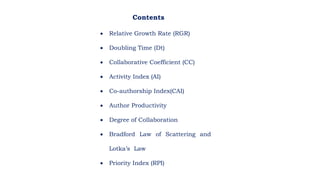
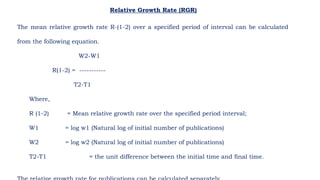
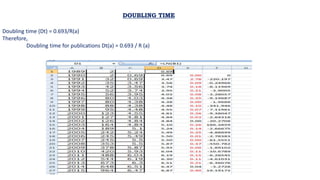
![The pattern of co-authorship among different countries have been examined by
making use of Collaborative Coefficient (CC) suggested by Ajiferuke e.tal (1988).
The formula used for calculating CC is as follows. Where
k
CC=1-[â (1/j)Fj/N]
J=1
Fj=the number of authored papers
N=total number of research published; and
k=the greatest number of authors per paper
COLLABORATIVE COEFFICIENT (CC)](https://image.slidesharecdn.com/relativegrowthrateppt-221214072208-bc4ae1d8/85/Relative-Growth-Rate-ppt-ppt-4-320.jpg)
